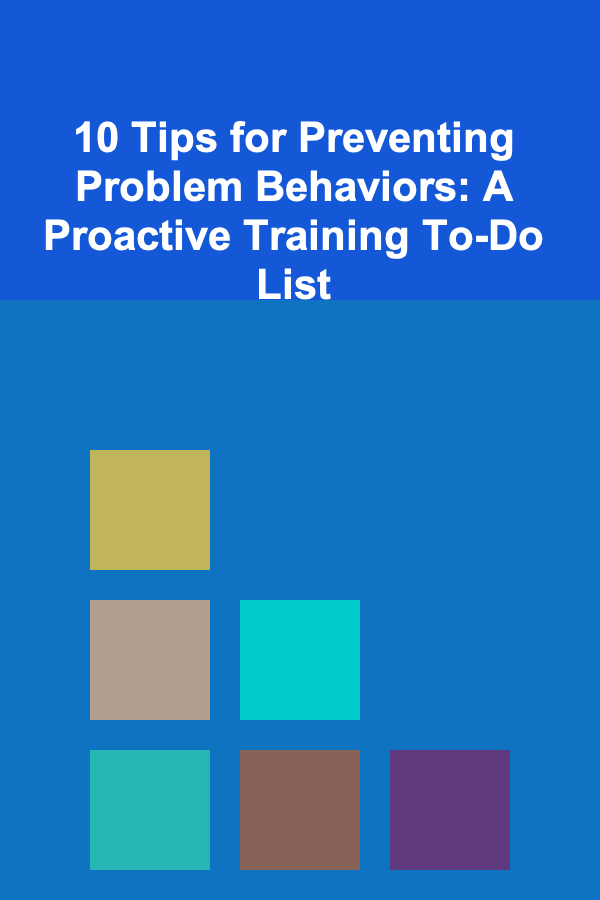
10 Tips for Preventing Problem Behaviors: A Proactive Training To-Do List
ebook include PDF & Audio bundle (Micro Guide)
$12.99$11.99
Limited Time Offer! Order within the next:

Problem behaviors, whether in children, employees, or even pets, can create substantial challenges in various environments. These behaviors can range from simple distractions to more serious disruptions that affect productivity, relationships, and overall well-being. While reactive strategies are important in managing problem behaviors, proactive strategies---those that aim to prevent these behaviors from arising in the first place---are often more effective in the long run.
In this article, we will discuss 10 practical and proactive training tips that can help prevent problem behaviors. These strategies can be applied across various contexts, whether you're a parent, manager, teacher, or pet owner, and are designed to foster a positive environment where problem behaviors are minimized.
Establish Clear Expectations
One of the first steps in preventing problem behaviors is to set clear and consistent expectations. Whether at home, in the workplace, or at school, individuals need to understand what is expected of them. This clarity eliminates confusion and provides a clear framework for behavior.
Action Steps:
- Define Behavior: Be specific about what constitutes acceptable and unacceptable behavior. For instance, if you are a teacher, rather than saying, "Be respectful," you might say, "Raise your hand before speaking."
- Communicate Expectations: Make sure to communicate these expectations regularly and clearly. In a workplace, you might send out regular reminders or include behavioral expectations in training materials.
Why This Works:
Clear expectations reduce ambiguity and help individuals understand the boundaries of acceptable behavior. This proactive approach minimizes the likelihood of individuals engaging in problematic behavior out of confusion or misunderstanding.
Provide Positive Reinforcement
Rather than focusing only on punishing undesirable behaviors, it is essential to emphasize and reinforce desirable behaviors. Positive reinforcement involves recognizing and rewarding good behavior, which encourages individuals to repeat these actions.
Action Steps:
- Reward System: Implement a reward system where individuals earn points, praise, or other incentives for demonstrating desired behaviors.
- Immediate Reinforcement: Provide immediate feedback when the behavior is displayed. This can be as simple as a verbal acknowledgment like, "Great job on being punctual today!"
Why This Works:
Positive reinforcement increases the likelihood of a behavior being repeated. When individuals feel recognized for their good behavior, they are more likely to continue behaving in that manner, preventing issues from escalating.
Use Consistent Consequences
While positive reinforcement is vital, it is equally important to establish consistent consequences for inappropriate behavior. The key is consistency---when people know that a certain action will always lead to a specific consequence, they are less likely to engage in that behavior.
Action Steps:
- Set Boundaries: Clearly outline the consequences for specific behaviors. For example, if an employee repeatedly misses deadlines, the consequence could be a reduction in responsibilities or a formal warning.
- Follow Through: Stick to the consequences you've set. Inconsistent enforcement can lead to confusion and defiance.
Why This Works:
Predictable consequences help prevent problem behaviors by making individuals aware that certain actions are unacceptable and will be addressed. It also ensures fairness and prevents frustration that can arise from inconsistency.
Develop Strong Relationships
Building strong, respectful relationships with those under your care or supervision can be one of the most effective ways to prevent problem behaviors. People are less likely to engage in negative behaviors if they feel valued, understood, and connected to the person they are interacting with.
Action Steps:
- Active Listening: Take the time to listen to concerns or feedback from others. This shows that you respect their opinions and care about their well-being.
- Empathy: Show empathy for their struggles or challenges. Acknowledging their feelings can help build trust and reduce the likelihood of negative behavior.
Why This Works:
When people feel respected and understood, they are more likely to engage in positive behaviors. Strong relationships create a sense of loyalty and respect, which diminishes the likelihood of disruptive behaviors.
Promote Self-Regulation Skills
Helping individuals learn how to manage their own behavior is an essential skill for preventing problem behaviors. Self-regulation skills such as impulse control, emotional regulation, and conflict resolution can make a significant difference in maintaining order and harmony.
Action Steps:
- Teach Coping Mechanisms: In a school or home setting, teach children coping strategies for managing frustration or anger, such as taking deep breaths or counting to ten.
- Provide Autonomy: Allow individuals to have a voice in decision-making processes to promote ownership of their actions. Giving them choices enhances their sense of control over their behavior.
Why This Works:
When individuals possess strong self-regulation skills, they are better able to control their impulses and respond to situations in a calm, controlled manner. This leads to fewer instances of problem behaviors.
Create a Structured Environment
A well-structured environment can prevent many behavioral problems by reducing unpredictability and providing a framework within which individuals can operate. Having a clear structure can help individuals stay focused and organized, thus reducing stress and behavioral issues.
Action Steps:
- Routine: Establish consistent daily routines. For example, children benefit from knowing that after school they will have a set time for homework and a set time for play.
- Clear Boundaries: Define physical and social boundaries. In a workplace setting, this may mean having clearly designated spaces for collaboration versus individual work.
Why This Works:
Structure creates predictability, which in turn helps individuals feel secure and focused. When people understand what to expect and when, they are less likely to engage in negative or disruptive behaviors.
Provide Opportunities for Success
A key preventative strategy is to ensure that individuals have opportunities to succeed. If they are regularly presented with tasks that are too difficult or not within their skill set, they are more likely to engage in problem behaviors due to frustration.
Action Steps:
- Scaffold Tasks: Break tasks down into manageable steps. This is particularly important in educational settings, where some students may struggle with complex tasks.
- Set Achievable Goals: Help individuals set realistic, achievable goals that will lead to success. Recognize and celebrate their achievements along the way.
Why This Works:
When people experience success, they feel more confident and capable. This boosts morale and reduces the likelihood of frustration or disengagement, which are often precursors to problem behaviors.
Model Desired Behaviors
People, especially children and employees, often learn by watching others. If you model the behaviors you wish to see in others, you set a powerful example. Leading by example helps individuals internalize the values and behaviors you expect from them.
Action Steps:
- Demonstrate Respect and Patience: Show respect and patience in your interactions with others. If you model these behaviors, others are more likely to mirror them.
- Practice Consistency: Be consistent in your actions and words. If you expect others to be punctual, make sure you lead by arriving on time yourself.
Why This Works:
Modeling positive behaviors helps others understand how to behave in various situations. By seeing the desired behaviors in action, individuals are more likely to imitate them.
Implement Preventative Distractions
In many situations, problem behaviors arise because individuals are bored, stressed, or over-stimulated. By providing appropriate distractions or outlets, you can prevent the escalation of these behaviors.
Action Steps:
- Engage in Activities: Introduce engaging and interesting activities that keep individuals occupied. For example, use games, puzzles, or creative activities for children.
- Provide Breaks: Regular breaks can help prevent burnout or frustration. In workplaces or schools, incorporate regular, structured breaks to reduce stress and improve focus.
Why This Works:
Preventing boredom and stress can significantly reduce the likelihood of negative behaviors. When individuals have appropriate outlets for their energy and emotions, they are less likely to engage in disruptive actions.
Monitor and Adjust Approaches Regularly
Finally, it is important to continually monitor the effectiveness of your proactive strategies and make adjustments as needed. Flexibility and adaptation are key components of preventing problem behaviors.
Action Steps:
- Evaluate Outcomes: Regularly evaluate how well your strategies are working. Are problem behaviors decreasing? Are individuals responding positively to your approach?
- Make Adjustments: Based on your observations, adjust your strategies. If certain techniques are not working, be willing to try new methods.
Why This Works:
Regular monitoring ensures that your approach remains effective and that you are adapting to changing circumstances. It also allows you to address any emerging issues before they escalate into more significant problems.
Conclusion
Preventing problem behaviors is far more effective than dealing with them reactively. By setting clear expectations, using positive reinforcement, creating a structured environment, and modeling the behaviors you want to see, you can proactively reduce the likelihood of disruptive behavior. These strategies not only promote a positive and productive environment but also build a foundation for long-term success and harmony. With consistent effort and a proactive approach, you can foster an environment where problem behaviors are minimized, and everyone has the opportunity to thrive.
Reading More From Our Other Websites
- [Personal Care Tips 101] How to Apply Brow Gel for a Bold, Defined Brow Without Overdoing It
- [Soap Making Tip 101] Best Community‑Driven Soap‑Making Challenges on Social Media
- [Home Soundproofing 101] How to Soundproof with Fiberglass Insulation for Better Noise Control
- [Home Maintenance 101] How to Maintain Your Home's Water Filtration System for Clean Water
- [Rock Climbing Tip 101] Training Plans That Work: Building Strength and Endurance for Lead Climbers
- [Home Renovating 101] How to Update Your Home's Exterior Without a Full Remodel
- [Personal Finance Management 101] How to Create a Budget That Works for You
- [Weaving Tip 101] Best Loom Types for Weaving: Choosing the Right Tool for Your Creative Vision
- [Organization Tip 101] How to Arrange Vintage Finds in a Cohesive Style
- [Home Pet Care 101] How to Clean Your Pet's Teeth: A Step-by-Step Guide to Good Dental Care

How to Build a Checklist for Identifying Low Stock Items
Read More
How to Organize a Shared Room for Siblings
Read More
How to Screen Tenants Without Discriminating
Read More
How to Stage a Rental Property for Higher Returns
Read More
How to Write Effective Loglines and Synopses
Read More
How to Protect Your Child's Identity from Day One
Read MoreOther Products

How to Build a Checklist for Identifying Low Stock Items
Read More
How to Organize a Shared Room for Siblings
Read More
How to Screen Tenants Without Discriminating
Read More
How to Stage a Rental Property for Higher Returns
Read More
How to Write Effective Loglines and Synopses
Read More